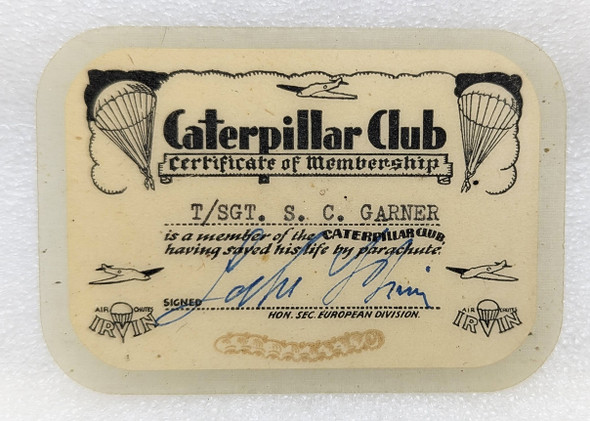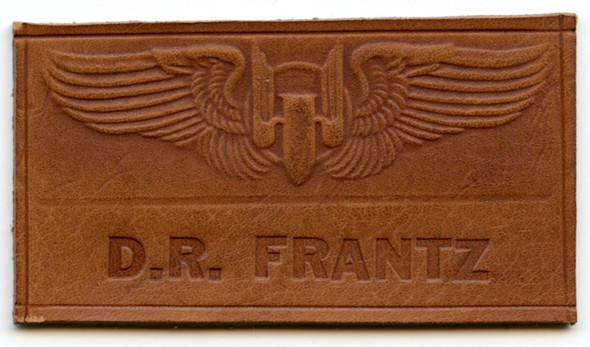Late WWII 8th AF 453rd BG 733rd BS Caterpillar Club Pin & Card Flight Engineer T/Sgt Harry J. Fink
- SKU:
- afpg20453ctpd
Frequently bought together:
Description
ARTIFACT:
VINTAGE:
View AllClose
What we have here is the original Late WWII Switlik Caterpillar Club Lapel Pin, and the Caterpillar Club Membership Card of Technical Sergeant Harry Judson Fink of Pennsylvania. The pin is made of gold plated and enameled brass, and the card is printed paper, laminated years ago to be proudly carried by T/Sgt. Fink.
Thankfully, the events that lead to T/Sgt Fink's membership in the Caterpillar Club have been memorialized on the web. Sadly, he was one of only 4 members of his crew of 10 to survive the event.
From the National Museum of the Mighty Eighth Air Force Facebook Page:
EDWIN & EDWARD HENSLEY - IDENTICAL TWINS LOST IN WAR
Edwin was a Staff Sergeant in the U.S. Army Air Forces 733rd Bomber Squadron, 453rd Bomber Group, Heavy, 8th Air Force. His identical twin brother, also a Staff Sergeant, Edward J Hensley, was killed with him over the North Sea, and were declared as Missing in Action. Both were awarded the Air Medal with Oak Leaf Cluster and are commemorated together on the Tablets of the Missing. They entered the Service from North Carolina.
It was the 17th mission of the B-24 bomber # 42-51149 "Blood and Guts" (the plane received its name because it hit and killed hundreds of birds on a test flight when taking off!) was part of the 8th Air Force, 453rd Bombardment Group, 733rd Bombardment Squadron on 17 February, 194It flew at least 8 missions with 389th Bomb Group and 35 missions with 453rd Bomb Group.
It was forced to ditch in the North Sea, 9 miles North of Cromer, Norfolk after severe icing while returning from a recalled mission to Magdeburg, Germany. It was forming on buncher 6 over the North Sea about halfway between England and Norway, and climbing and circling through 10/10ths cloud cover with de-icer boots on.
Only four of the 10-man crew were recovered. The survivors were Lt. Charles M. Frank [co-pilot], Lt. Harold E. Prout [navigator], Lt. Harry Stein, and T/Sgt. Harry J Fink [flight engineer].
Those who lost their lives were: 1st. Lt. Lawrence Macdonald Duncan, [1st pilot] T/Sgt. R.A. Beltz, S/Sgts L. Patsey and J.N. Redman, and the identical twins S/Sgts. Edward J. Hensley and Edwin J. Hensley.
The ship that came to the rescue was the British minesweeper H.M.S. Dark Waters, commanded by Captain Rodney S. Pelham.
Survivor, T/SGT Fink would later recount his chilling experience:
We were forming on buncher 6 over the North Sea about halfway between England and Norway. We were climbing and circling through 10/10ths cloud cover with our de-icer boots on. As the flight engineer, I was monitoring the de-icers from the flight deck and reporting to Lt. Duncan whether we were icing up or not. WE
definitely were, and after reporting this, Mac hit the alarm button.
The next thing I heard was "For Christ's sake, Charlie, get out of here!" Charlie was our navigator, Lt. Charles Frank. The plane made a shallow slide to the left as if falling out of the air. I had my chest pack sitting on the flight deck bench; I grabbed it and turned to Mac who was frantically trying to fly straight and level so all of us could get out of the plane. I asked Mac if there was anything I could do and he said, "Harry, get out of here; I'm right behind you!"
I snapped on my chest pack and climbed into the bomb bay. I took one last look back at the flight deck where it seemed that Mac was getting ready to leave the ship. That was the last time I was to see Lt. Duncan. I dove headfirst into the overcast and pulled the ripcord handle and nothing happened. I reached up to the zeus fasteners holding the chute closed and pulled up; the pilot chute came flying out, cracking me across the right eye but happily pulling the main chute after it.
As my chute opened I came through the overcast happy and thankful that I had exited the plane safely. But my joy was short-lived as I looked below to see the forbidding expanse of the North Sea offering the choice of freezing to death or perhaps drowning if the chute settled over my head upon landing. Unfortunately, we had not had time to send out even one "May Day," therefore no one knew we had gone down. Luckily the wind was in my face as I hit the water, causing my chute to settle in back of me, enabling me to scramble out of the harness and to inflate my Mae West.
The next thing I did was to start swimming - toward France? - toward England? - toward Norway? After three or four strokes I realized, even in my befuddled mind, that I was not going to swim to safety from the middle of the North Sea, so I settled in the water with my Mae West holding my chin just above the waves, waiting for I really didn't know what. I do remember thinking; "my loss is going to kill my mother."
I had no sense of how much time had passed, but it had to be less than half an hour because Capt. Pelham told me later that the temperature of the water was eight degrees above freezing that day, and even with all the gear on, a human being could live less than half an hour in it. Like something out of a movie I had seen, a ship came over my limited horizon. I began waving frantically and
yelling until I realized that in all this vastness of water I was not going to be seen and I would be passed by. Then the miracle started to happen.
The ship was getting larger as it turned toward me. In a matter of minutes that seemed like an eternity, the ship stopped dead in the water, lowered a dinghy with four or five British seamen in it. Rowing
furiously, they reached me quickly, all the time yelling for me to keep moving and talking to them. They pulled alongside me and tried to pull me into the boat. They were unable to do that, so two of the seamen removed their outer clothing and dived into the icy water to push me up into the boat, and then back to the ship.
The ship that rescued me was the British minesweeper H.M.S. Dark Waters, commanded by Capt. Rodney S. Pelham. Capt. Pelham told me later that he had cut the sweep off the stern of the ship in order to be able to maneuver faster to get to me. He also told me that if it had been a British airman in the same circumstances, he would have had to maneuver his ship with the sweep on. His words were, "I had instructions to pick up Americans at all costs."
Here I offer some imponderables, or at the very least, some ironies. What are the odds of a lone human head being spotted in the very choppy North Sea on a gray overcast day from the crow's nest of a 22,000-ton minesweeper? Further ironies are Capt. Pelham saying his squadron of three minesweepers were the only Allied ships in that area of the North Sea that day, and it was the first time in two years his squadron had been in those waters. Of course, the biggest imponderable of all is: why me? I truly believe the only answer is that God saved me so I could take care of my mother as my Dad passed away ten days before I got home from overseas.
World War II.
SIZE:Approximately Card: 2-5/8" in height x 3-11/16" in width. Caterpillar Pin: 3/16" in height x 7/8" in width.
CONSTRUCTION / MATERIALS:Gold plated and enameled brass, and the card is printed paper.
ATTACHMENT:Single screw post with disc backing.
MARKINGS:N/A.
ITEM NOTES:This is from a USAAF collection which we will be listing more of over the next few months. MAJJV18 LHIEX09/01/25
CONDITION:8+ (Excellent): The card shows moderate wear and pin shows little to minor wear, Overall, it is in excellent condition.
GUARANTEE:As with all my artifacts, this piece is guaranteed to be original, as described.















